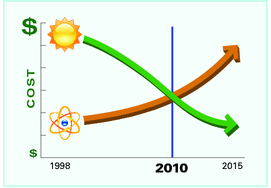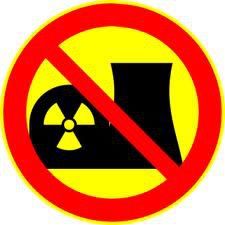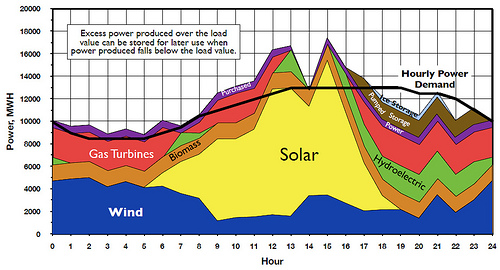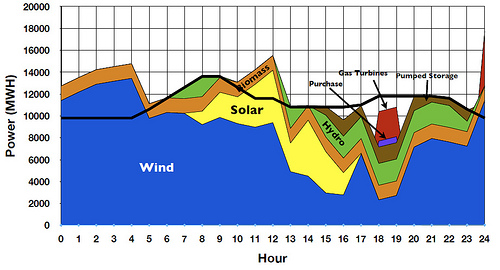Here's some hard evidence of FERC Chairman Jon Wellinghoff's assertion back in 2009 that baseload is outdated, we don't need any new nukes or coal, because we can get all the new power we need from sun and wind. This study from North Carolina goes further: we don't need coal or nukes at all.
John Blackburn, Ph.D. wrote a report March 2010, Matching Utility Loads with Solar and Wind Power in North Carolina: Dealing with Intermittent Electricity Sources,
Takoma Park, Maryland, and Durham, North Carolina, March 4, 2010: Solar and wind power can supply the vast majority of North Carolina's electricity needs, according to a major report released today. Combined with generation from hydroelectric and other renewable sources, such as landfill gas, only six percent of electricity would have to be purchased from outside the system or produced at conventional plants.
Hourly Power Generation and Load for a sample day in July
"Even though the wind does not blow nor the sun shine all the time, careful management, readily available storage and other renewable sources, can produce nearly all the electricity North Carolinians consume," explained Dr. John Blackburn, the study's author. Dr. Blackburn is Professor Emeritus of Economics and former Chancellor at Duke University.
"Critics of renewable power point out that solar and wind sources are intermittent," Dr. Blackburn continued. "The truth is that solar and wind are complementary in North Carolina. Wind speeds are usually higher at night than in the daytime. They also blow faster in winter than summer. Solar generation, on the other hand, takes place in the daytime. Sunlight is only half as strong in winter as in summertime. Drawing wind power from different areas — the coast, mountains, the sounds or the ocean — reduces variations in generation. Using wind and solar in tandem is even more reliable. Together, they can generate three-fourths of the state's electricity. When hydroelectric and other renewable sources are added, the gap to be filled is surprisingly small. Only six percent of North Carolina's electricity would have to come from conventional power plants or from other systems."
Six percent is a small number. That means most coal plants could be shut down, and no nukes are needed.
Hourly Power Generation and Load for a Sample Day in January
There's no need to be alarmed by the mention of biomass: the study seems to be referring to biomass gas generated from landfills.
We've already seen such projections for the entire U.S. from Mark Z. Jacobsen, without any need for coal, nuclear, or biomass energy. This North Carolina report is a specific application to one state. Application to Georgia would no doubt be different (fewer mountains, more sun). It's also years later already, which means solar is even less expensive. How about we do the study and find out?
The actual report considers various methods of load balancing already in use. Clever, that one of making ice off-peak and using it for air conditioning during the day.
North Carolina has several means of evening out differences between variable generation and load from hour to hour within days, but very limited ability to carry stored energy forward from day to day. The hydroelectric system is already used as a means to meet peak demands with a generation system heavily oriented toward baseload generation. In addition, there is pumped storage capacity in the Duke Energy system amounting to 2,100 MW, of which 1,360 MW has up to 24 hours of storage. In the summer, hourly storage is supplemented by the capacity of some large commercial customers to make ice in off-peak times and then run air conditioning systems without running the chillers at peak times in the afternoon and evening. In addition, the two largest utilities now have some 2,000 MW of load control arrangements.
Then the report looks at actual hour-by-hour data from various sites, and runs the numbers, including for expanding all three of the above methods of storage, plus load control, price-induced demand shifts, and vehicle batteries. One conclusion they reach is:
They permit the utility systems to operate with a complement of backup generation capacity which is smaller than the backup facilities commonly used in the present systems and their huge centralized coal or nuclear baseload plants.
 We've heard from Dr. Blackburn before, about
the price of solar now being less than the price of nuclear,
especially when you factor in construction costs.
We've heard from Dr. Blackburn before, about
the price of solar now being less than the price of nuclear,
especially when you factor in construction costs.
Some auxiliary non-renewable power would still be needed. However:
In these simulations, purchased power is limited to 5% of system demand and auxiliary power is minimized, based on a probability of need given the other parameters of the system. 2,700 MW, used at a 22% capacity factor, appears to be sufficient. This is, incidentally, much less than the existing gas-fired capacity in North Carolina (over 6900 MW).
I'd bet the natural gas auxiliary power needs for Georgia would also be less than the existing gas-fired capacity in Georgia, especially after all the natural capacity Oglethorpe Power and Georgia Power have added in recent year. And that bet is for even after all the coal plants in Georgia were shut down. As the report indicates, baseload is an anachronism whose time has already passed:
…with these characteristics of flexible grids, the absence of huge quantities of baseload power (none of which is included in this scenario) is of little consequence.
 Who wants
to do the study to find out how we can power Georgia
primarily with sun and wind?
Who wants
to do the study to find out how we can power Georgia
primarily with sun and wind?
The scenarios in this report only begin to tap the true potential of solar power:
Solar radiation falling on North Carolina each day is more than 400 times larger than annual energy use in the State.
And Georgia, especially south Georgia, is south of North Carolina, and has more sun.
We'll get to widescale use of clean renewable wind and solar energy faster once we get past this problem:
Jim Warren, Executive Director of the North Carolina Waste Awareness and Reduction Network (NC WARN), added, "Utilities and their allies are pressing policy-makers to allow construction of expensive and problem-ridden nuclear reactors—with ratepayers and taxpayers absorbing enormous financial risks.
 We don't need expensive nuke boondoggles.
We don't need expensive nuke boondoggles.
Southern Company and Georgia power need to spend that CWIP money on
fast-deployed, clean, and renewable wind and solar power.
It’s time for them to do what Austin Energy and Cobb EMC have already done:
 turn away from dirty energy sources like coal and get on with
installing solar and wind power generation:
for jobs, for energy independence, and for profit.
turn away from dirty energy sources like coal and get on with
installing solar and wind power generation:
for jobs, for energy independence, and for profit.
-jsq
Short Link:

